AMD Radeon HD 6850 Overclocking Roundup: Asus, XFX, & MSI
by Ryan Smith on November 8, 2010 12:40 AM ESTPower, Temperature, & Noise
With the variety of card designs it’s the difference in power draw, heat dissipation, and acoustics that truly separate the cards. It’s not just the difference in physical designs that helps set these cards apart, but also how the manufacturer has decided to tune the cards to balance these attributes. A balanced card is usually the most desirable.
| Radeon HD 6850 Load Voltage | |||||
| Ref 6850 | XFX 6850 | MSI 6850 | Asus 6850 | ||
| 1.094v | 1.148v | 1.148v | 1.148v | ||
As we noted in the introduction, all of our 6850s except the reference card have a load voltage of 1.148v, versus 1.094v. We’re still trying to get to the bottom of the issue, but in the meantime this means all of these cards run worse than the reference 6850 when it comes to power consumption.
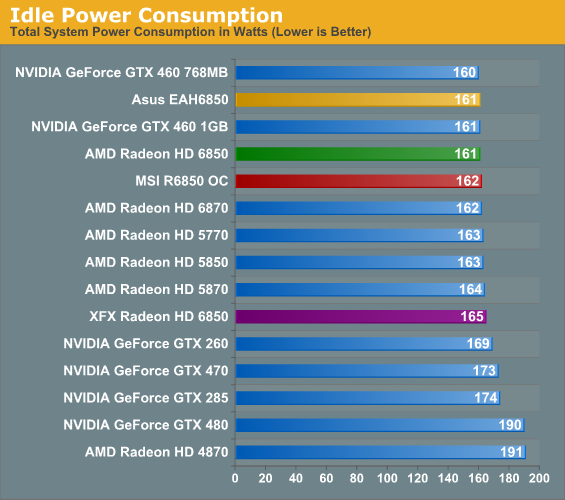
Out of our 3 partner cards and our reference card, our idle power results are tightly clustered among all of the 6850s except for the XFX card which draws a few more watts at idle. We believe this is due to XFX’s fan choice, though we can’t rule out component selection either.
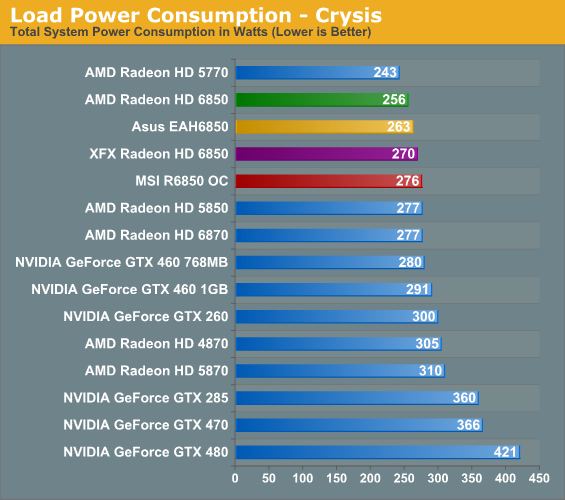
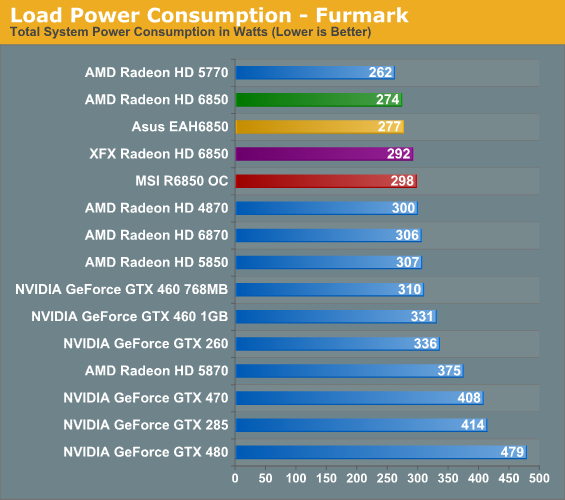
In terms of power consumption the Asus card is closest to the reference 6850, followed by the XFX and then the MSI card. This isn’t particularly good for XFX here, as the other partner cards all have at least a token overclock while the XFX card is doing notably worse than the 6850 reference cards even though it’s operating at the same clockspeeds. Even compared to the Asus card it’s doing worse here.
Meanwhile the MSI R6850 ends up being rather close to the 5850. Given that it achieves 5850-like performance, this isn’t particularly surprising.
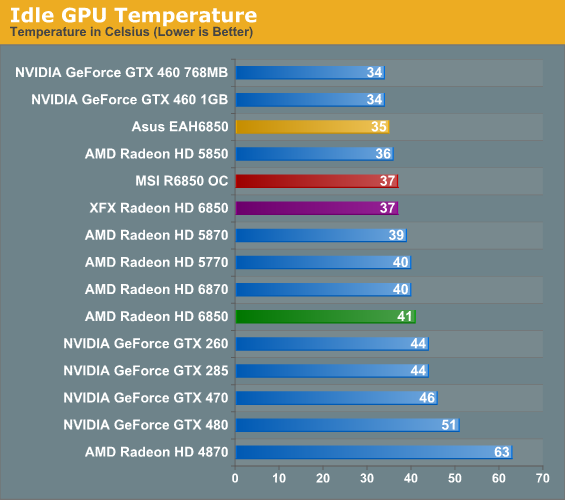
All 3 partner cards do better than the 5850 when it comes to idle temperatures thanks to their open designs. The price of a fully exhausting design is more noise and higher temperatures, which the reference 6850 pays the price for here.
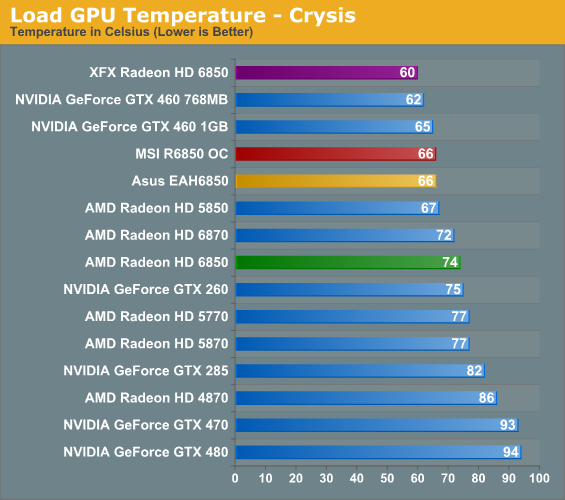
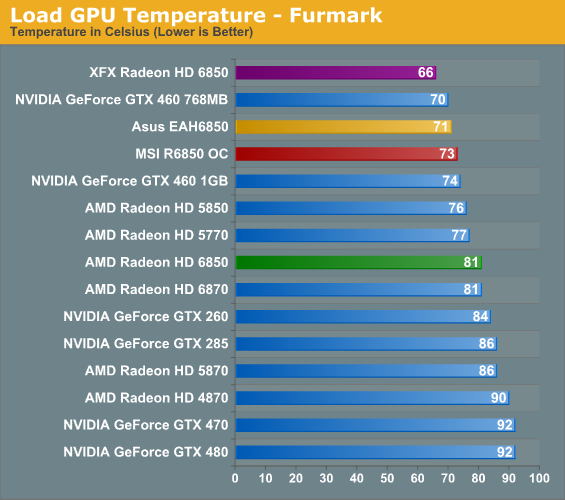
Once again the open coolers on the partner cards give them a significant leg up over the reference card. Even with the reference card’s lower power consumption, it runs hotter than all the open cards as we’d expect. Topping this chart is the XFX card, which with XFX’s extreme focus on cooling manages to hit only 60C on Crysis and 66C under FurMark. This is followed by the Asus and MSI cards, which are neck-and-neck, which is a reasonable outcome given the similarities between their coolers. All of the partner 6850s end up doing better than the NVIDIA GTX 460 1GB, which uses a cooler similar to the XFX card.
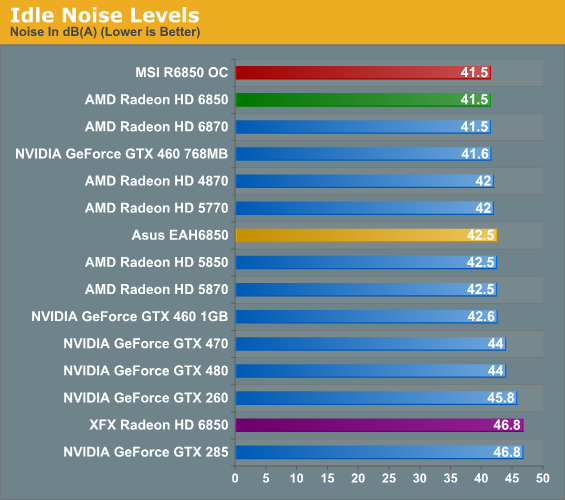
At idle most cards run up against our noise floor. The standouts here are the Asus card, which ends up being a dB over the quietest cards, while the XFX card does significantly worse here at 46.8dB. In practice the Asus card shouldn’t be any worse than the other cards, but the XFX is noticeable (but not distracting) at idle.

It’s when we move to looking at load noise that we see our 6850 cards significantly separate. The reference 6850 was a tough card to beat here being that it was tuned for noise, but Asus did it, coming in at 45.3dB, quieter than any reference card in its class. Meanwhile the MSI and XFX cards do significantly worse; the XFX at 59dB is outright loud, but this was a conscious design decision on XFX’s part to focus on cooling over noise concerns. MSI on the other hand has a card with similar temperature characteristics as the Asus card, but does significantly worse than the Asus card when it comes to noise. It’s difficult to do a straight comparison here, as while both cards have the same load voltage, the MSI card has a much larger overclock than the Asus card. The MSI card still seems too loud for what it is, even though the amount of noise is comparable to the 5850 and other cards with a similar power draw.










93 Comments
View All Comments
JPForums - Monday, November 8, 2010 - link
The EVGA GTX460 FTW used in the previous article can be found at newegg for $229.99/$239.99 (less $10 if you rely on MIRs).The cards in this article can be found at newegg for $184.99/$189.99.
Ignoring all the flak anandtech took for including the FTW card in the first place, you are still talking two different price categories.
While I'm in favor of comparing of including OC competition in an OC review, it isn't an absolute necessity.
Further, it would be irresponsible to compare cards in different price categories.
Given the variation in price from these OC units and how much they fluctuate, its near impossible to keep such an OC comparison relevant for long enough to be useful.
As such, I don't mind the lack of OC competition.
In fact, I think Ryan did a great job by focusing heavily on the AMD to AMD (6850 OC vs 6870 stock) comparison.
As long as the same rules apply when nVidia's new cards (stock and OC) come out, I see nothing to complain about.
7Enigma - Monday, November 8, 2010 - link
I disagree. Very few people are hard-capped at exactly X dollars. If I see that $20 more buys me 20% more performance I may just decide to shell out a bit extra coin. Taking this a step further, what is the point in including the GTX480? It's not even close to being in the same price category. It's used as a metric to show just what higher-end cards can do, and allows for the reader to quickly judge how long a past top-of-the-line part still has life before contemplating replacement with a middle-tier part.Personally to prevent muddying the charts I think one step above and below the price category (say +/- $50-75 for low/mid-range parts) is really all that is needed, but that SHOULD include the FTW. It's up to the reader to decide if the extra money, heat, noise, etc. is worth it for better performance. I do have to admit though that I like comparing my aging 4870 to the competition and it was nice to see it displayed in this review to remind me of the performance increase I could be seeing on my gaming system (currently game at 19" LCD so it's tough to justify as everything still plays great at that low resolution).
totenkopf - Monday, November 8, 2010 - link
7Enigma, read the title. If you are concerned with relative performance at given price points for the purpose of informed shopping, seek out articles similar to 'best graphics cards for the money' articles like Tom's runs. Also, criticizing their decision to include the 480 because of price seems irrelevant, they are measuring the performance of various 6850's as per the title, the rest of the cards are just simple reference.In this case, an additional $75 dollars represents around 40% of these cards initial cost. That's a pretty big extra expense. If i were in the market for a $20,000 car, I wouldn't see myself casually spending an extra $8,000 to take advantage of a deal. Presumably, this article is aimed at readers who already have decided on the 6850 and want to know more about those particular cards, not readers shopping different price points.
If Nvidia feels the OCed 460 is a better representation of that model, then they should respec the 460 at those speeds (i.e. GTX465). Until then, respect ATs decidion to leave out non-reference boards unless they are particularly relevant to the article (GTX 460 roundup). For reviews to remain relevant they must measure the nominal performance of specific models so average readers don't get confused/misled; people like you are already very well informed about the ever changing GPU market.
Willhouse - Tuesday, November 9, 2010 - link
I would also like to see an overclocking comparison between Nvidia and AMD. I reveiewed the article here:http://www.anandtech.com/show/3810/nvidias-geforce...
The nvidia cards are behind by ~6 fps in crysis and more or less equal on Bad Company 2. That appears to be the only apples to apples games comparison.
However, there is a key difference. No attempt was made to overclock the Nvidia memory, which you claim is key in the AMD article. I'm no expert, so maybe nvidia memory doesn't overclock well and the comparison is fair. However, there does not appear to be an apples to apples comparison in the recent AMD article, and I think this is worth a revisit.
Willhouse - Tuesday, November 9, 2010 - link
Oops, sorry. I re-read the 6850/70 launch article and the GTX460 FTW performance is a pretty fair comparison (the memory was overclocked somewhat) to the cards from this article. Its omission from this article is strange to me though.blandead - Monday, November 8, 2010 - link
why would the gtx460 ftw it has nothing to do with this, go cry a river.its about 3 overclocked cards and reference others. not super super overclocked 460 ftw which is a competitor to 6870 in first place. so yea go look if you want.
vedye - Monday, November 8, 2010 - link
The damage to Anandtech's image is already done. Before I easily trust every words it says. Now I look at these articles with grins of salt. It's a commercial website after all. Just read it as a joke.Minion4Hire - Monday, November 8, 2010 - link
??????Are you kidding? You're kidding, right?
Anandtech is a site that gives a shit about its readers. They respond very well to feedback and always try to do well by their audience. You have literally NO clue about what this site is about and what they have done over the years.
This supposed OC 460 debacle is a joke. I read the original article without the slightest problem with it and was entirely surprised when a bunch of oversensitive people got all butt hurt over nothing. What's wrong with comparing any given card(s) at any given price point(s)? The data speaks for itself. EVGA managed to offer one very competitive GTX 460. Kudos to them. I really don't care where or how Anandtech sourced said 460, they were able to include it in the article and that's awesome. The more data the better.
Seriously, Ryan, Anand, just do your thing. Don't worry about offending anyone and don't hold back. You guys serve up great content, and have consistently done so for some time now. I and many others look forward to the rest of your Barts coverage as the other 6000-series products trickle their way into the market.
vedye - Tuesday, November 9, 2010 - link
This "supposed OC 460 debacle" is a joke to you because you are a NV fan. I am using a GTX480 but I'm disgusted by NV's PR actions.Did NV PR called Anandtech asking him to include an OC 460? Yes he did. And he included a limited edition that has the highest OC percentage. No matter what you say.
AnnonymousCoward - Tuesday, November 9, 2010 - link
Limited edition? Is that why it has been for sale, in stock, ever since the article came out??The debacle was a complete joke. As if it shouldn't be allowed to compare a product with "OC" in the model number, because model numbers really mean so much.